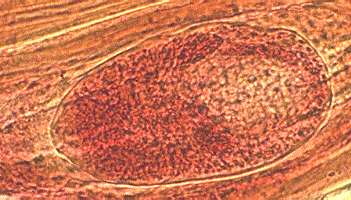The use of vectors and intermediate hosts is a common method for parasites in aquatic habitats to transmit to the next host in the life cycle. Parasites enter vectors passively, as the vectors are feeding. The parasite then undergoes some development or replication in the vector. When the vector seeks out a new host to feed on, it also introduces the parasites it is harboring. Parasites may enter intermediate hosts actively or passively. Once inside they usually transform into a stage that can resist the defense responses of the intermediate host, and persist for long periods, until that host is eaten by another animal that can serve as a second intermediate host or definitive host.
Blood parasites such as the intercellular Trypanosoma danilewskyi (top) in fish, and the intracellularHaemogregarina (bottom) in frogs, use leeches as vectors.


Many cestodes use crustaceans as a first intermediate host for their procercoid stage.

If these cestodes use a second intermediate host, it is usually a fish which feeds on the crustacean and becomes infected with a plerocercoid stage.

Many digeneans with aquatic life cycles use a second intermediate host to get from the snail first intermediate host to the definitive host.
Typically, a metacercaria will encyst in the muscles or other tissues of the second intermediate host. Fish and insect larvae are popular choices, but many other animals are used as hosts as well.


Some species produce a metacercarial stage that does not encyst, such as a diplostomulum which remains free in the muscles, brain or eye.

All acanthocephalans use intermediate hosts for the cystacanth stage. Although transmission is passive, via the food chain, many species alter the behavior of their intermediate host to render it more susceptible to predation by a suitable definitive host.
Nematodes frequently use fish as an intermediate host. The third stage larva is present in muscles (below) or in other organs.
